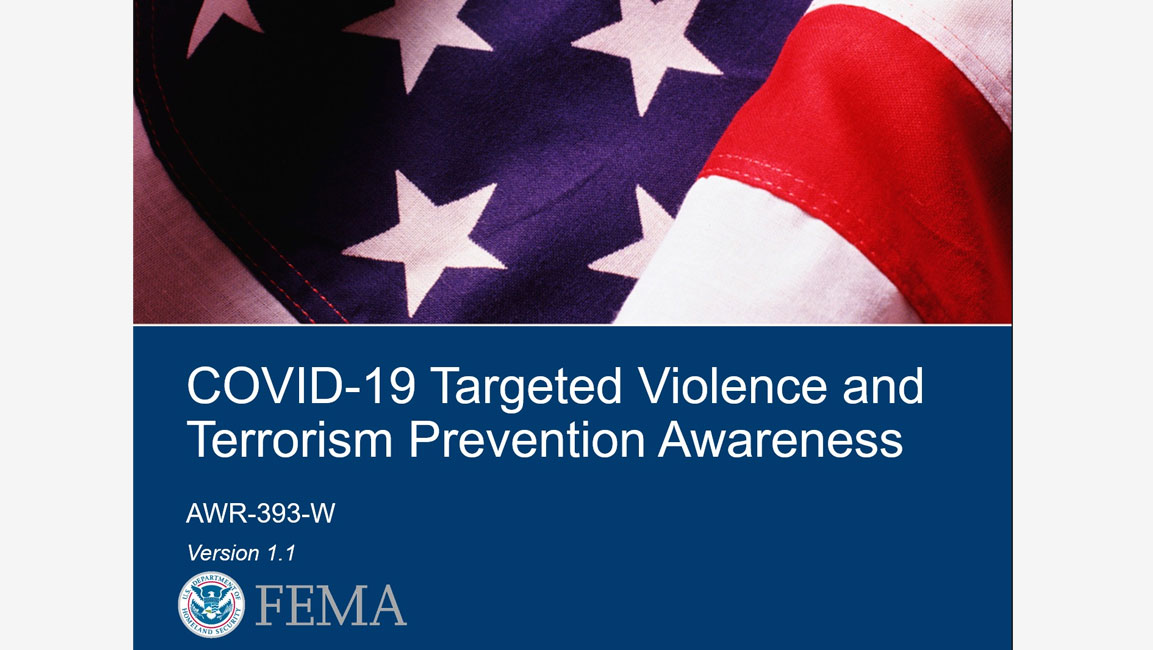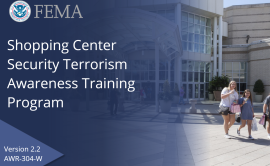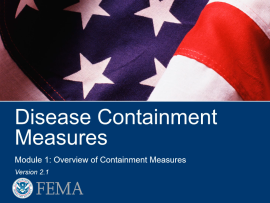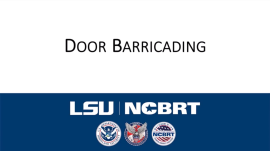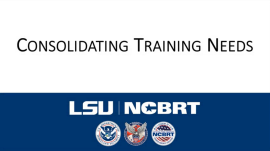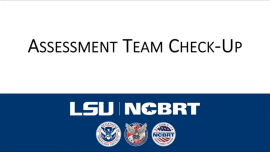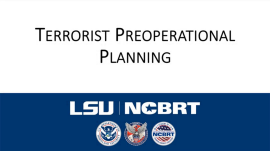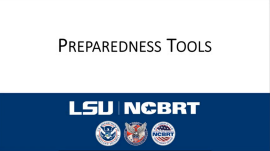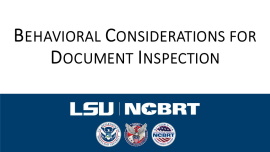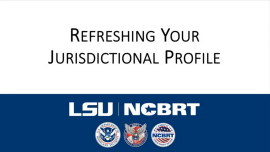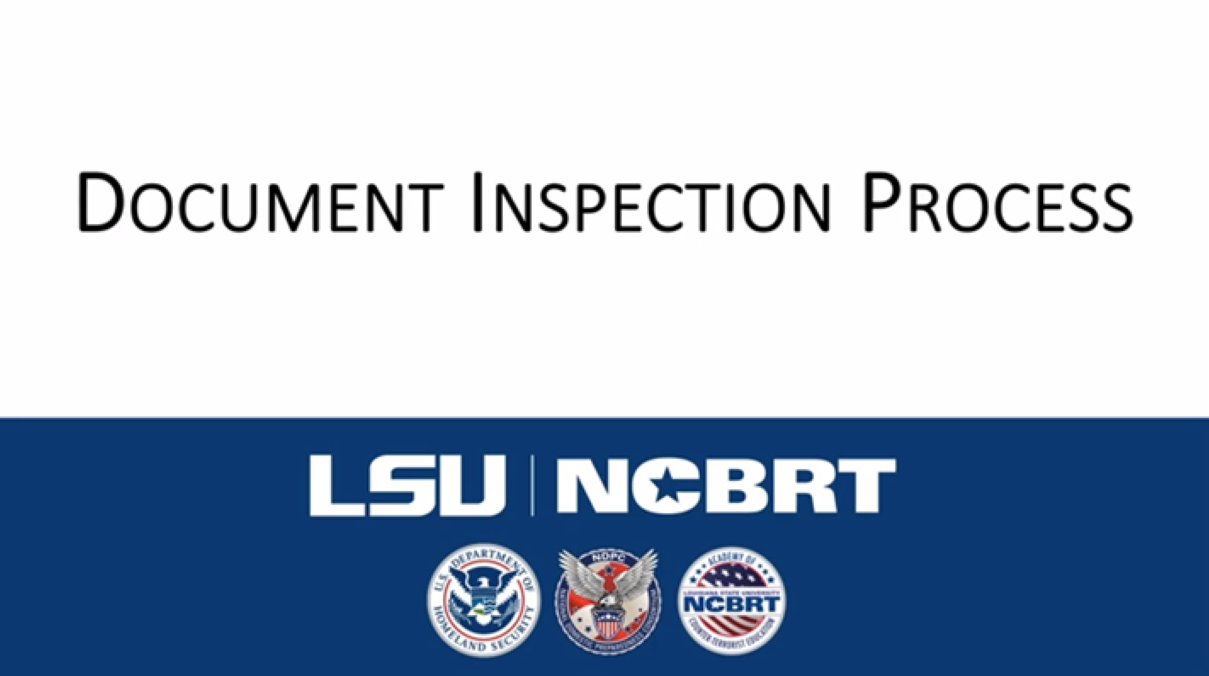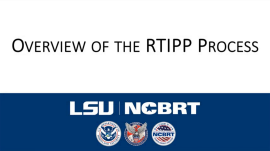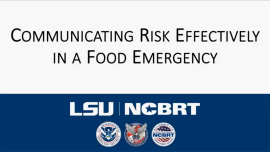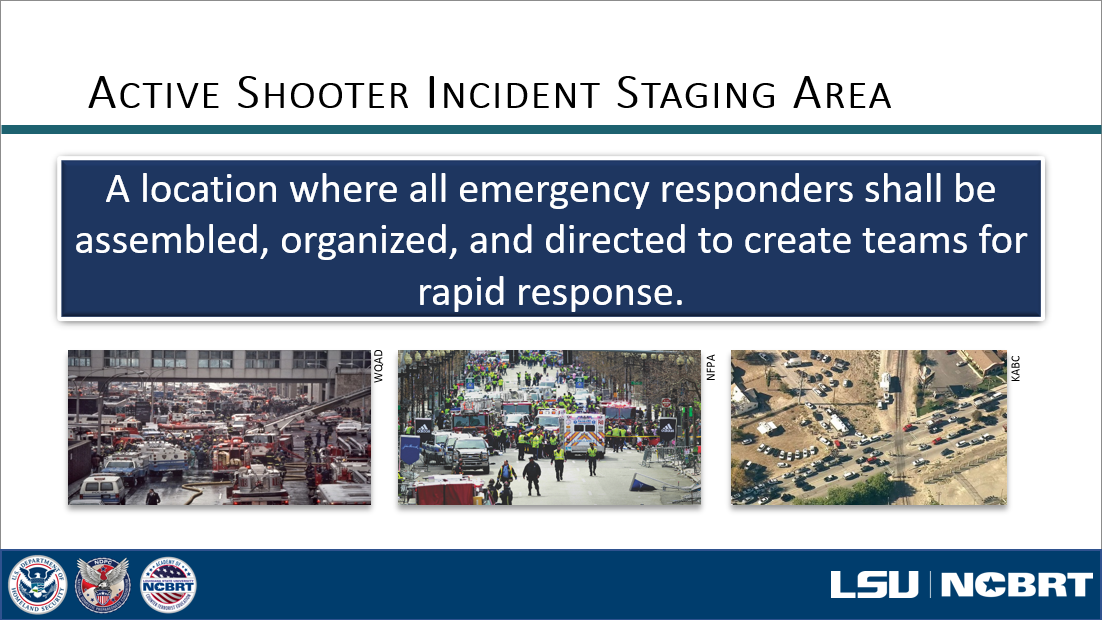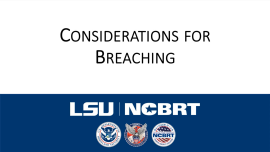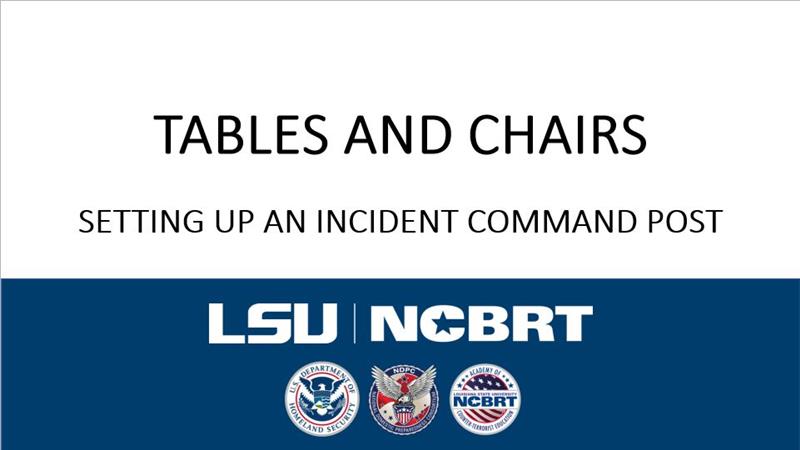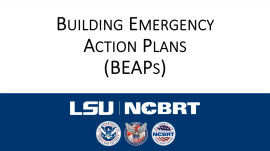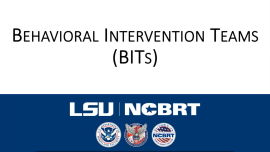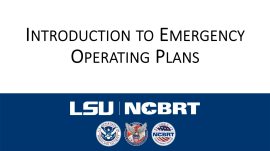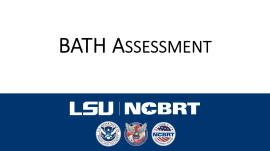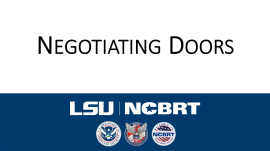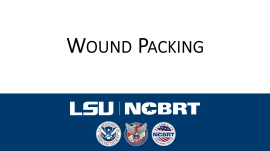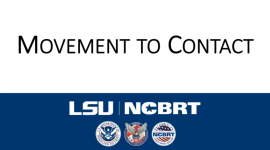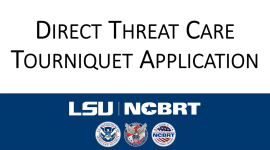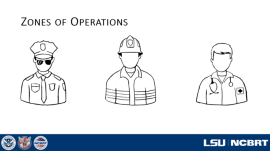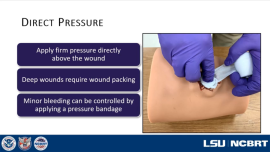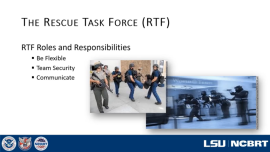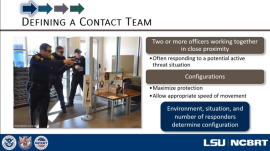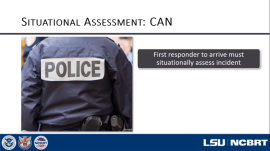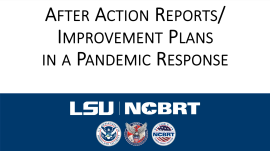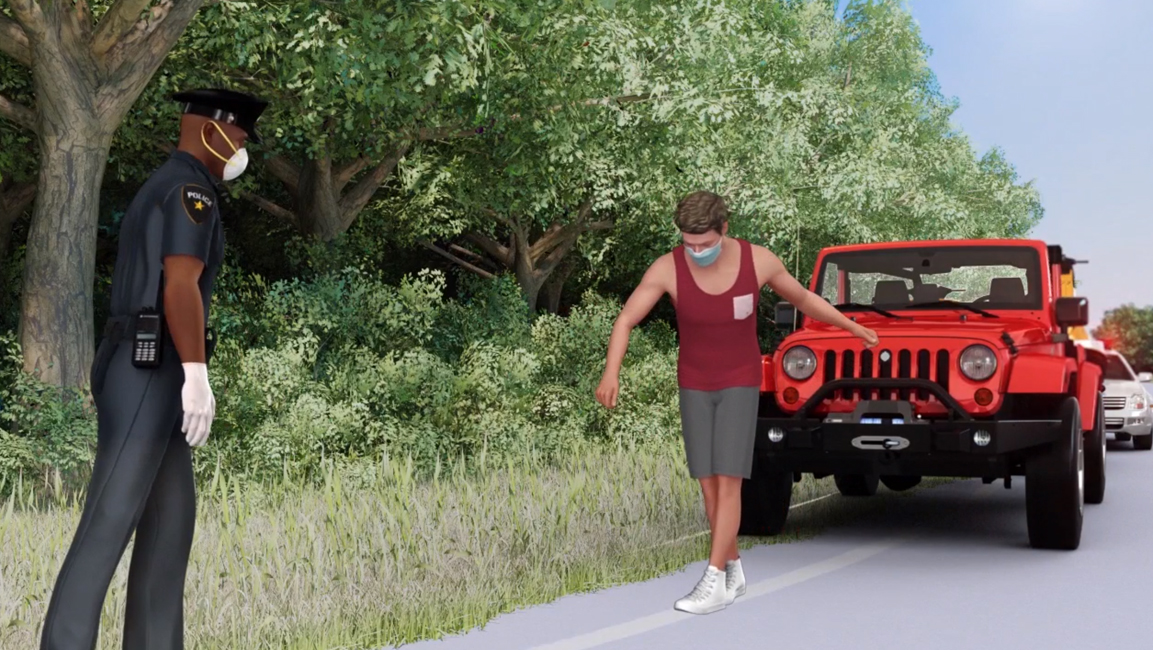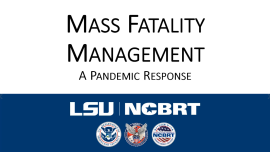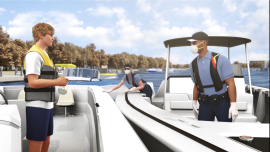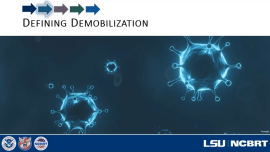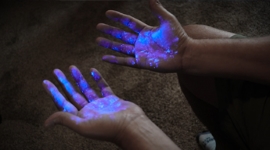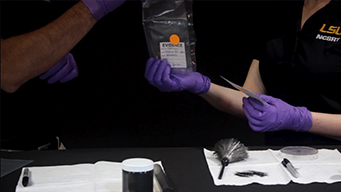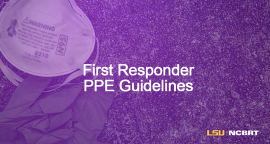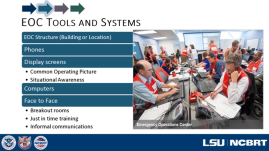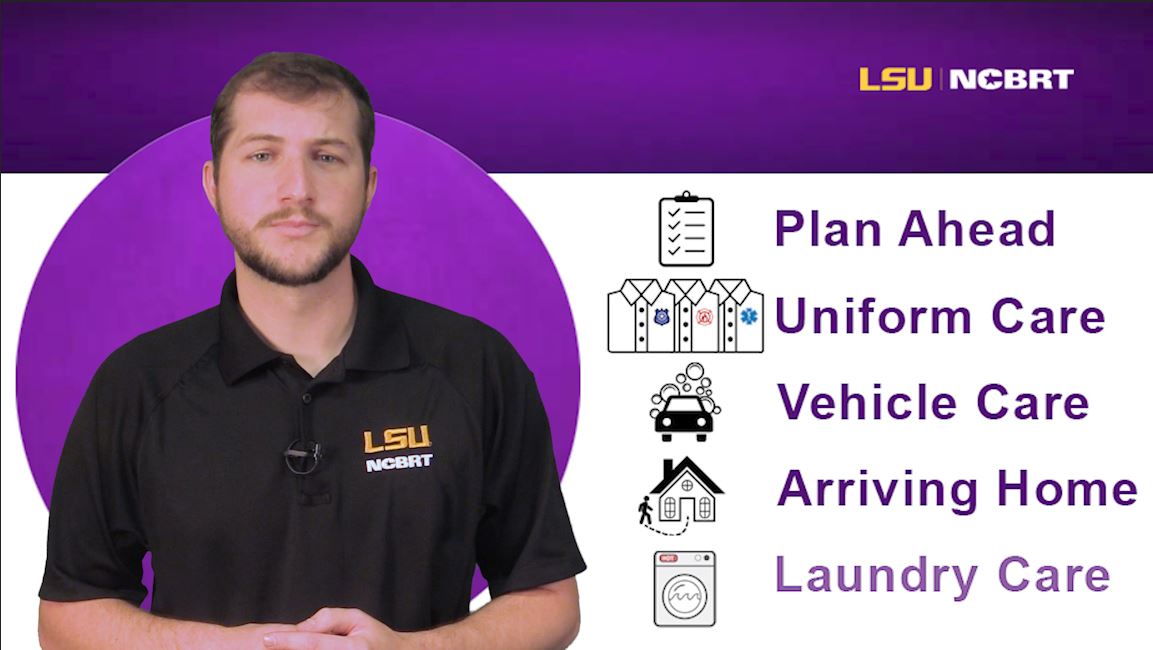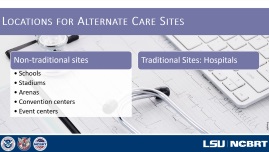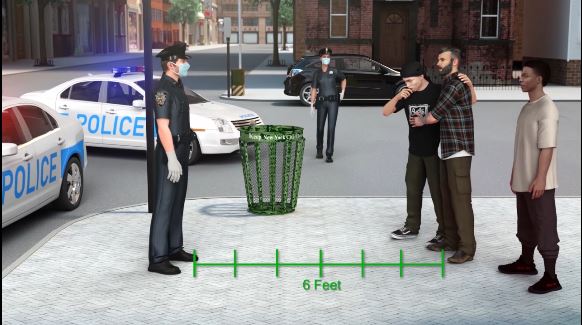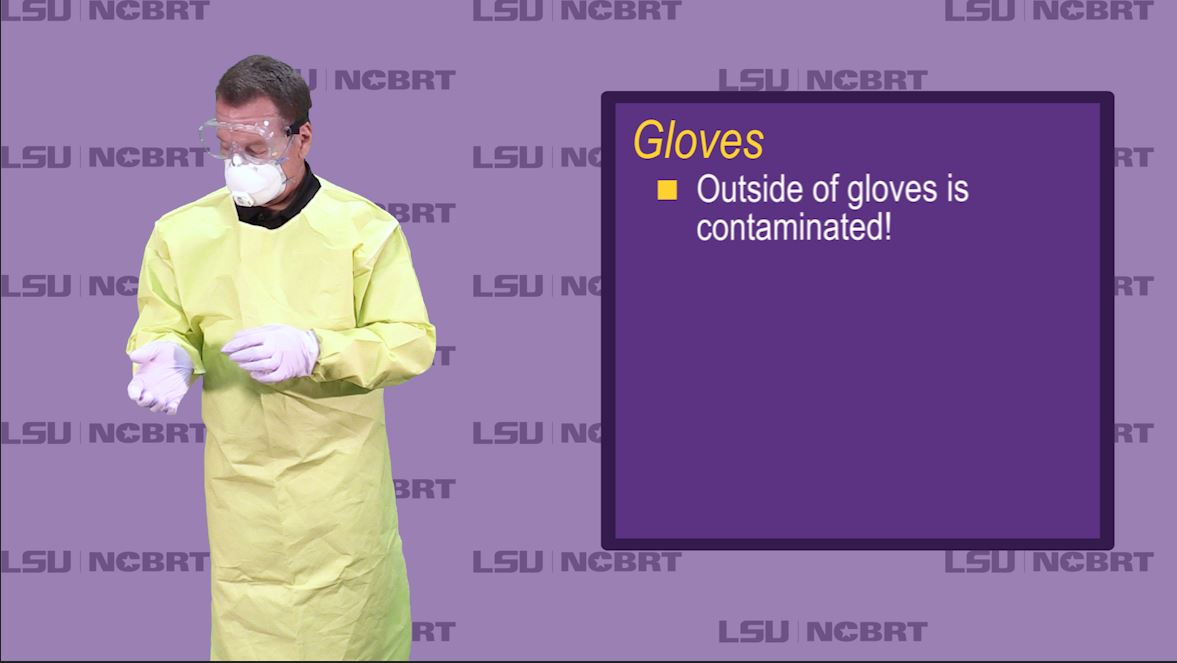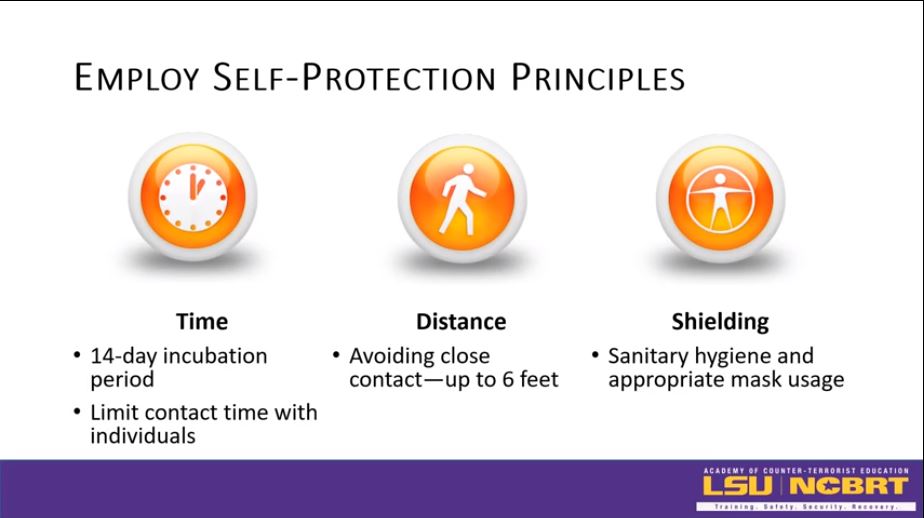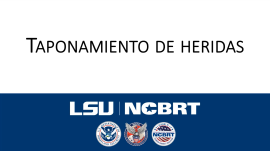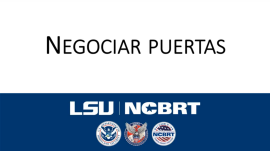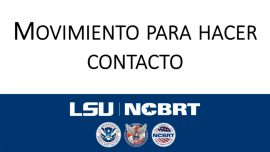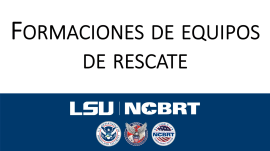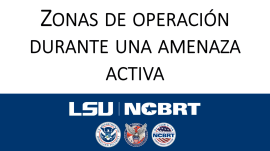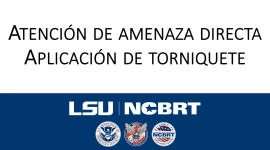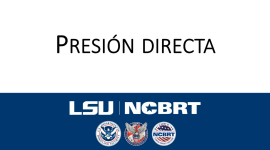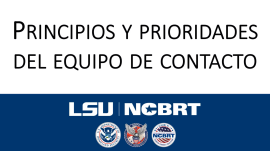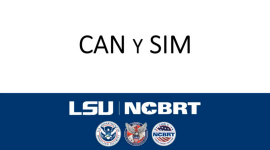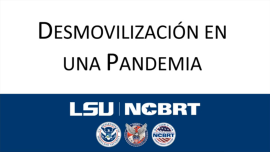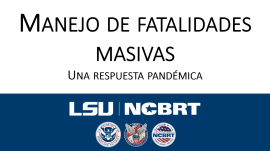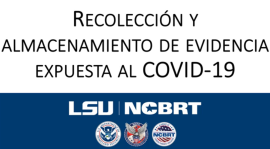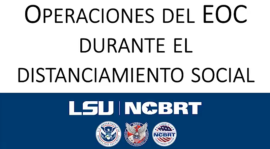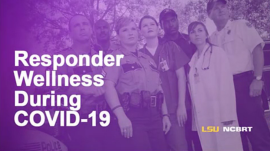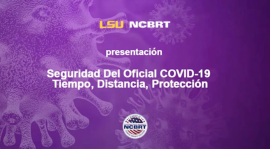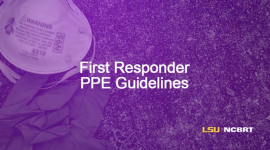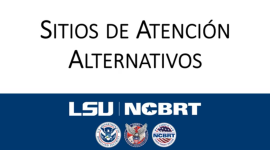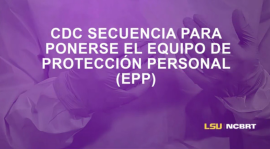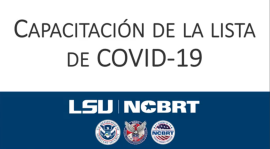NCBRT/ACE eLearning Courses
The content below is hosted on Moodle and requires a login. Registration is simple and provides instant access to course content. Click the New User button above to register and access this free training. Course offerings are organized by type: DHS/FEMA Certified Courses, Micro Modules, and Webinars. Some content is also available in Spanish, and is listed separately below.
DHS/FEMA Certified Courses
These training courses are certified by DHS/FEMA and offer a certificate of completion and continuing education units. Participants are required to obtain a FEMA Student ID (SID) prior to enrolling in these courses.
COVID-19 Targeted Violence and Terrorism Prevention Awareness (AWR-393-W)
This awareness-level course will prepare participants to recognize every day and opportunistic threats occurring in the COVID-19 response environment. Participants will receive an overview of response activities they can take to increase their situational awareness and ability to response to threats outside of the COVID-19 threat.
Shopping Center Security Terrorism Awareness Training Program (AWR-304-W)
This course provides security training personnel with increased awareness of the various facets of terrorism and criminal activity that could occur at a retail facility. During this course participants will examine weapons that may be used in a terror attack and will be able to describe various attack tactics that may be used against a retail facility. Participants will also be able to assess potentially suspicious behavior and will be able to conduct surveillance at their facility. The course describes proper response to terrorist or criminal incidents.
Disease Containment Measures (AWR-323-W)
This course provides training on the indicators related to various disease containment measures as well as detailed information on the declaration, implementation, and suspension efforts required during disease containment efforts. The course focuses on the roles of community agencies as well as how these agencies must integrate their efforts to successfully respond to a disease-related emergency. Case studies are used to provide real-life exposure to social distancing, quarantine, and isolation events.
Micro Modules
Micro Modules are brief, webinar-formatted presentations based on NCBRT course content. They may be used as review or refresher for users who have previously taken NCBRT training or serve as an introduction to topics for those who have not completed the related course. Certificates of completion are available for each Micro Module.
Door Barricading
The purpose of this presentation is to provide demonstrations of effective door barricading techniques. During an active threat incident, it is important for individuals to place as many obstacles and time-consuming barriers between themselves and the threat as possible. Taking steps to impede or stop the progress of a threat could increase survivability and save lives. Participants are encouraged to apply principles from this course to plans and procedures in their workplaces.
Consolidating Training Needs
The purpose of this presentation is to illustrate the benefits of consolidating training needs into a jurisdictional multiyear training plan. This plan provides opportunities for interagency collaboration and training. It allows jurisdictions to train with other agencies or jurisdictions that will be responding during an emergency. Consolidating several agencies’ needs into one jurisdiction-wide training plan allows agencies with common training goals to work together, share resources, and provide each other with help and support. Multidisciplinary training can lead to a better-informed, better-connected response community, and a far more successful response.
Assessment Team Check-Up
The purpose of this presentation is to teach emergency planners how to ensure that their training assessment team includes members that adequately represent the jurisdiction. Team members from the whole community will be responsible for completing the assessment process. The team will analyze response capabilities to identify training needs, develop training goals for the jurisdiction, identify training sources, and create a multiyear training plan.
Facial Image Comparison
The purpose of this presentation is to outline the practical steps of facial image comparison when examining photo identification documents. This course provides participants with the skills to evaluate the authenticity of identification documents and ensure that documents are lawfully possessed. The course provides techniques participants can use during the interview process to identify imposters that include comparing the face of the person presenting the document to the photograph on the document, Identifying the principle features of the subject’s face to see if it matches the photograph, and more.
Terrorist Preoperational Planning
The purpose of this presentation is to provide an overview of the preoperational activities leading up to a planned terrorist attack. Preoperational Planning can be done secretly and remotely, over several months or years. This presentation identifies those preoperational behaviors so that participants can learn to better recognize suspicious activities that could indicate a terrorist attack.
Preparedness Tools
The purpose of this presentation is to provide an overview of the documents that planning teams should refer to when completing a readiness assessment. By evaluating their abilities to meet their emergency operations plan (EOP) using traditional and national preparedness tools, participants learn that agencies that plan and train together are much better equipped to successfully respond together.
Behavior Considerations for Document Inspection
The purpose of this presentation is to review some of the behavioral considerations for the inspection of identity documentation. This course provides participants with the skills to evaluate the authenticity of identification documents and ensure that documents are lawfully possessed. This course provides a professional and comprehensive examination of overt and covert security features of genuine current state drivers licenses and federal travel documents. It also provides tools and techniques that participants can use during the interview process to identify imposters and to examine identification documents that subjects present to them.
Refreshing Your Jurisdictional Profile
The purpose of this presentation is to provide guidance on how emergency planners can understand and enhance their jurisdictional profiles. Constantly changing communities must plan for threats and their associated needs must be consistently and continuously reviewed. Response communities, resource groups, and critical infrastructure must also be identified within the established geographic region.
Document Inspection Process
The purpose of this presentation is to review the process and considerations for the inspection of identity documentation. This course provides participants with the skills to evaluate the authenticity of identification documents and ensure that documents are lawfully possessed. It also provides tools and techniques that participants can use during the interview process to identify imposters and to examine identification documents that subjects present to them.
Overview of the RTIPP Process
The purpose of this presentation is to provide an overview of the seven steps in the Readiness: Training Identification and Preparedness Planning process. The RTIPP process assists jurisdictions efficiently plan and schedule training that is relevant to community preparedness. It is critical that agencies within a jurisdiction plan and train together so they can respond effectively when an incident occurs. In an all hazards, whole community approach, public sector agencies, private sector organizations, and nongovernmental organizations all play a role in preparedness.
Communicating Risk Effectively in a Food Emergency
The purpose of this presentation is to provide an overview of risk communication and the guidelines and strategies for developing effective risk communication in a food emergency.
Staging in an Active Shooter Incident
The purpose of this presentation is to provide a focused overview of staging and staging concepts for all responders as well as law enforcement. It also provides tactical approach, tools, and resource considerations for a response attributed to an intentional act by individuals that creates or evolves into an active shooter incident or complex coordinated attack (CCA).
Mechanical Breaching
The purpose of this presentation is to provide examples of mechanical breaching for law enforcement. The video will review methods of mechanical breaching including: forcing, cutting and crushing or breaking.
Consideration for Breaching
The purpose of this presentation is to provide an informational introduction for basic considerations during breaching for law enforcement officers. The content reviews entry points and mechanical breaching tools.
Tables and Chairs: Setting Up An Incident Command Post
The purpose of this presentation is to provide participants one example of physically establishing an incident command post (ICP). During an emergency, it is critical for individuals to know their various roles and responsibilities as well as how information should flow within the ICP.
Building Emergency Action Plans (BEAPs)
The purpose of this presentation is to provide an informational introduction for Building Emergency Action Plans, or BEAPs. A BEAP details emergency actions at the building level, including occupant actions and should support an Emergency Operations Plan.
Behavioral Intervention Teams (BITs)
The purpose of this presentation is to provide an informational reminder of key principles for Behavioral Intervention Teams. BITs are formed to respond to the early detection of and intervention of worrisome or potentially harmful behavior and to prevent campus violence. These BITs provide a centralized point to which concerned members of the campus community can report instances of worrisome or potentially harmful behavior.
Introduction to Emergency Operations Plans (EOPs)
The purpose of this presentation is to provide an informational introduction for Emergency Operating Plans, or EOPs. An EOP serves as the cornerstone of preparedness and emergency activities of a campus. This presentation provides resources for campuses to begin developing their EOPs.
Pressure Points
The Pressure Points video illustrates how to use pressure points in controlling severe bleeding as a first step before tourniquet application or wound packing occurs.
BATH Assessments
The LSU NCBRT/ACE BATH Assessments presentation is part of a series of micro modules based on certified course content. The purpose of this presentation is to provide emergency responders an overview or refresher of key principles for BATH Assessments. Using this simple assessment tool, responders identify and treat life-threatening bleeding, maintain an open airway, monitor for signs of tension pneumothorax, and attempt to maintain the victim’s body temperature to prevent hypothermia.
This presentation was created using content from NCBRT's PER-340, Active Threat Integrated Response Course.
Negotiating Doors
This presentation provides emergency responders an overview or refresher of key principles for negotiating open and closed doors as they clear rooms during an active threat situation. When responders make room entries, they must move quickly and decisively through the door and prepare to engage the threat.
Wound Packing
The purpose of this video presentation is to provide emergency responders an overview or refresher of key principles of wound packing. Wound packing is performed during the indirect threat care phase of an incident when there is no active threat. It may be used to control severe bleeding in places where tourniquets are not effective, such as bleeding near the junction of the torso and a limb.
Movement to Contact
The Movement to Contact micro module provides emergency responders an overview or refresher of key principles for team movement as they move to mitigate an active threat. This presentation looks at team sizes and configurations, as well as the advantages and disadvantages of a few common ones.
Direct Threat Care - Tourniquet Application
The purpose of this presentation is to remind Emergency Responders of key tourniquet application principles in a direct threat care environment.
Zones of Operation During an Active Threat
Zones of operation are defined by the relative level of threat. These designations determine where certain actions and specific personnel are allowed to operate. As a result, and for a safer and more efficient response, we identify and label areas at the scene based on our knowledge of the potential threat(s) in each of those areas. We do this by assigning identifiers: the hot zone, the areas of highest risk; the warm zone, an area of intermediate risk; and the cold zone, areas of least risk with regard to the incident.
This presentation was created using content from NCBRT’s PER-340, Active Threat Integrated Response Course.
Direct Pressure
The purpose of this presentation is to remind emergency responders of key principles for applying direct pressure to injuries sustained during an active threat incident when tourniquets may not be an option.
This presentation was created using content from NCBRT’s PER-340, Active Threat Integrated Response Course.
Rescue Task Force Formations
The purpose of this presentation is to provide Emergency Responders an informational reminder of key principles surrounding the formation and response of a Rescue Task Force (RTF) in an active shooter or active threat incident.
This presentation was created using content from NCBRT’s PER-275, Law Enforcement Active Shooter Emergency Response, and PER-340, Active Threat Integrated Response Course.
Contact Team Principles and Priorities
This presentation will address contact team concepts, principles, and priorities. These include solo officer entries, bypassing the wounded, and directing follow-on responders.
This presentation was created using content from NCBRT’s PER-275, Law Enforcement Active Shooter Emergency Response, and PER-340, Active Threat Integrated Response Course.
CAN and SIM
The purpose of this presentation is to remind Emergency Responders of key principles of CAN (Conditions, Actions, and Needs) reports, and using SIM (Security, Immediate Action Plan, Medical Intervention) during an active threat incident. These principles can assist first responders to identify needs and rapidly respond to active threat incidents.
This presentation was created using content from NCBRT’s PER-335, Critical Decision Making for Complex Coordinated Attacks, and PER-340, Active Threat Integrated Response Course.
Webinars
Webinars are short training videos to provide instruction on specific topics. Certificates of completion are available for each webinar.
Fourth Generation Nerve Agents
This video provides the viewer information regarding fourth generation nerve agents (FGA). After viewing, you will understand FGA mechanisms of toxicity, signs and symptoms of FGA poisoning, medical countermeasures, and immediate protective actions to prevent further contamination.
After Action Reports/Improvement Plans During a Pandemic
NCBRT is presenting a two-part webinar on after action plans/improvement plans in a pandemic response.
Part 1 of this presentation provides a basic understanding of after-action reports/improvement plans, or AAR/IPs, during a major disaster such as a pandemic. We will discuss the key issues to address and some basic steps to use when writing an AAR/IP. The presentation will also define after-action reports/improvement planning and their importance for documentation and continued improvement activities during a pandemic response. We will identify how conducting an after-action report for infectious diseases, which are long-term, complex incidents, varies from AAR/IP reporting for other incidents.
In the second part of NCBRT’s presentation on after action plans/improvement plans in a pandemic response, we will focus on the mechanics of writing the report: what to include in the report, what sources may be used to obtain that information, and how to use the templates available for writing the report. It will also include a review of AAR/IPs written for the pandemic response to the H1N1 pandemic at the local, state, and federal level.
Time, Distance, Shielding - D.U.I.
In this short video, LSU NCBRT/ACE provides personal protective measure best practices that help minimize the spread of viral pathogens while conducting a field sobriety test.
Mass Fatality Management
This webinar focuses on tactics for managing fatalities resulting from COVID-19. This webinar will focus on how handling fatalities during a pandemic can differ from other types of disasters. It will also provide considerations for managing mass fatalities such as the storage of remains and methods of identification to assist in repartition to families.
Time, Distance, Shielding - B.U.I. on Water
In this short video, LSU NCBRT/ACE has partnered with NASBLA to provide personal protective measure best practices that help minimize the spread of viral pathogens while conducting the seated battery of standardize field sobriety testing (SFST).
Demobilization in a Pandemic
LSU NCBRT/ACE created the Demobilization in a Pandemic webinar to help individuals understand demobilization plans and procedures for jurisdictions, agencies, and departments under federal guidance during a pandemic. This webinar will explain the importance of plans, procedures and documentation during a major public health disaster such as a pandemic and how that affects the U.S. response at the federal, tribal, state and local levels.
Breaking the Chain: Preventing the Spread of Surface Contamination
This short video demonstrates the ease and prevalence of potential contamination by following the chain of contamination through ordinary, daily activities. The video also provides concrete, CDC-approved techniques that can help curb the spread of germs and contagious particles.
Handling COVID-19 Exposed Evidence
These two videos will highlight the proper precautions to take when conducting a crime scene investigation where the scene and the evidence are contaminated by COVID-19. The first video provides an overview of safely collecting and storing contaminated evidence, maintaining chain of custody, using exposed evidence in a court room, decontaminating evidence, and lab analyst protections. The second video lays out step-by-step procedures for safely collecting and packaging latent fingerprint, hair and fiber, serological, soil trace, impression, and document evidence.
First Responder PPE Guidelines
This 11-minute video provides an overview of protective gear available to responders for outbreak response. It addresses how the gear protects people, what its limitations may be, and techniques for properly donning and doffing PPE so responders can adequately protect themselves.
EOC Operations During Social Distancing
This webinar features protocol during social distancing for Emergency Operations Centers.
Responder Wellness During COVID-19
In this webinar, LSU NCBRT/ACE examines aspects of COVID-19 that may cause anxiety or stress for the responder community. The video also offers techniques that responders can practice to help manage or mitigate that anxiety.
Safer at Home
This short video provides tips for emergency responders on how to ensure that they are protecting themselves, their families and their homes from COVID-19 exposure after a shift.
Alternate Care Sites
The presentation includes information on setting up alternative care sites and how alternative sites can relieve some of the burden on hospitals.
Officer Safety: Time, Distance and Shielding
This animated video serves as a visual tool for highlighting the proper precautions that officers and emergency responders should take when performing their day-to-day operations during the COVID-19 pandemic.
CDC Sequence for Donning and Doffing PPE
This 6-minute video walks viewers step-by-step through the guidelines prescribed by the CDC for donning and doffing a gown, mask/respirator, face shield, and gloves.
COVID-19 Roll Call Training
This video provides information on how officers can keep themselves safe before, during, and after contact with others in the course of their job. It also addresses steps officers can take at the end of a shift to go home safely.
Micro Modules en Español
Taponamiento de Heridas
El propósito de esta presentación en video es brindar a los servicios de emergencia una descripción general o un repaso de los principios clave del Taponamiento de heridas. El taponamiento de heridas se realiza durante la fase de atención de amenazas indirectas de un incidente cuando no hay una amenaza activa. Puede usarse para controlar el sangrado severo en lugares donde los torniquetes no son efectivos, como el sangrado cerca de la unión del torso y una extremidad.
Negociar Puertas
Esta presentación proporciona a los servicios de emergencia una descripción general o un repaso de los principios clave para negociar puertas abiertas y cerradas mientras limpian las habitaciones durante una situación de amenaza activa. Cuando los socorristas ingresan a la habitación, deben moverse rápida y decisivamente a través de la puerta y prepararse para enfrentar la amenaza.
Movimiento Para Hacer Contacto
El micro módulo Movimiento para hacer contacto proporciona a los servicios de emergencia una descripción general o un repaso de los principios clave para el movimiento del equipo a medida que avanzan para mitigar una amenaza activa. Esta presentación analiza los tamaños y configuraciones de los equipos, así como las ventajas y desventajas de algunos de los más comunes.
Formaciones de equipos de rescate
El propósito de esta presentación es proporcionar al personal de respuesta a emergencias un recordatorio informativo de los principios clave que rodean la formación y respuesta de un Grupo de trabajo de rescate (RTF) en un incidente de tirador activo o amenaza activa.
Esta presentación se creó utilizando contenido de PER-275 de NCBRT, Respuesta de emergencia de tirador activo de aplicación de la ley, y PER-340, Curso de respuesta integrada a amenazas activas.
Zonas de Operacion Durante una Amenaza Activa
Las zonas de operación se definen por el nivel relativo de amenaza. Estas designaciones determinan dónde se permite operar ciertas acciones y personal específico. Como resultado, y para una respuesta más segura y eficiente, identificamos y etiquetamos áreas en la escena en base a nuestro conocimiento de las amenazas potenciales en cada una de esas áreas. Hacemos esto asignando identificadores: la zona caliente, las áreas de mayor riesgo; la zona cálida, zona de riesgo intermedio; y la zona fría, áreas de menor riesgo con respecto al incidente.
Esta presentación se creó utilizando contenido del PER-340, Curso de respuesta integrada a amenazas activas de NCBRT.
Atención de Amenaza Directa Aplicación de Torniquete
El propósito de esta presentación es para recordarle al personal de respuesta a emergencias los principios clave de la aplicación de torniquetes en un entorno de atención directa a amenazas.
Presión Directa
El propósito de esta presentación es recordarle a los servicios de emergencia los principios clave para aplicar presión directa a las lesiones sufridas durante un incidente de amenaza activa cuando los torniquetes pueden que no sean una opción.
Esta presentación se creó utilizando contenido del PER-340, Curso de respuesta integrada a amenazas activas de NCBRT.
Principios Y Prioridades del Equipo de Contacto
Esta presentación abordará los conceptos, principios y prioridades del equipo de contacto. Estos incluyen entradas de oficiales en solitario, evitando a los heridos y dirigiendo a los respondedores de seguimiento.
Esta presentación se creó utilizando contenido de PER-275 de NCBRT, Respuesta de emergencia de tirador activo de aplicación de la ley, y PER-340, Curso de respuesta integrada a amenazas activas.
CAN Y SIM
El propósito de esta presentación es recordarle al personal de respuesta a emergencias los principios clave de los informes CAN (Condiciones, Acciones y Necesidades) y el uso de SIM (Seguridad, plan de acción Inmediata, intervención Médica) durante un incidente de amenaza activa. Estos principios pueden ayudar a los socorristas a identificar necesidades y responder rápidamente a incidentes de amenazas activas.
Esta presentación se creó utilizando contenido del PER-335 de NCBRT, Toma de decisiones críticas para ataques coordinados complejos, y PER-340, Curso de respuesta integrada a amenazas activas.
Webinars en Español
Desmovilización en una pandemia
LSU NCBRT / ACE creó el seminario web Desmovilización en una pandemia para ayudar a las personas a comprender los planes y procedimientos de desmovilización para jurisdicciones, agencias y departamentos bajo la guía federal durante una pandemia. Este seminario web explicará la importancia de los planes, los procedimientos y la documentación durante un desastre de salud pública importante, como una pandemia, y cómo eso afecta la respuesta de los EE. UU. A nivel federal, tribal, estatal y local.
Manejo De Fatalidades Masivas
Este seminario web se centra en las tácticas para manejar las muertes resultantes de COVID-19. Este seminario web se centrará en cómo el manejo de las muertes durante una pandemia puede diferir de otros tipos de desastres. También proporcionará consideraciones para el manejo de muertes masivas, como el almacenamiento de restos y métodos de identificación para ayudar en la distribución a las familias.
Romper la Cadena: Evitar la Propagacion de la Contaminacion Superficial
Este breve video demuestra la facilidad y la prevalencia de la contaminación potencial siguiendo la cadena de contaminación a través de las actividades diarias ordinarias. El video también proporciona técnicas concretas aprobadas por los CDC que pueden ayudar a frenar la propagación de gérmenes y partículas contagiosas.
El manejo de COVID-19 de evidencia expuesta
Estos dos videos resaltarán las precauciones apropiadas a tomar al llevar a cabo una investigación de la escena del crimen donde la escena y las evidencias están contaminadas por COVID-19. El primer video proporciona una visión general de la recopilación y almacenamiento seguro de evidencias contaminadas, el mantenimiento de la cadena de custodia, el uso de evidencias expuestas en una sala de la corte, la descontaminación de evidencias y las protecciones de los analistas de laboratorio. El segundo video establece procedimientos paso a paso para recolectar y empaquetar de forma segura huellas dactilares latentes, cabello y fibra, serológicos, rastros de suelo, impresiones y documentos de evidencia.
Operaciones del EOC durante el distanciamiento social
LSU NCBRT/ACE presenta este webinario que incluye los protocolos durante el distanciamiento social para los Centros de Operaciones de Emergencia.
Salud del Respondedor Durante COVID-19
En este seminario web, LSU NCBRT/ACE examina aspectos de COVID-19 que pueden causar ansiedad o estrés para la comunidad de respondedores. El video también ofrece técnicas que los respondedores pueden practicar para ayudar a manejar o mitigar esa ansiedad.
Seguridad del Oficial: Tiempo, Distancia, Proteccion
Este video animado sirve como una herramienta visual para destacar las precauciones adecuadas que los oficiales y los respondedores de emergencia deben tomar al realizar sus operaciones diarias durante la pandemia de COVID-19.
Pautas de EPP para Personal de Respuesta
Este vídeo de 11 minutos ofrece una visión general del equipo de protección disponible para los respondedores para la respuesta al brote. Aborda cómo el equipo protege a las personas, cuáles pueden ser sus limitaciones y las técnicas para ponerse y quitarse EPP para que los respondedores puedan protegerse adecuadamente.
Sitios de Atención Alternativos
La presentación incluye información sobre la creación de sitios de atención alternativos y cómo los sitios alternativos pueden aliviar parte de la carga para los hospitales.
CDC Secuencia para Ponerse y Quitarse EPP
Un video de 6 minutos que guía a los espectadores paso a paso a través de las pautas prescritas por los CDC para ponerse y quitarse un vestido, máscara / respirador, protector facial, y guantes.
Mas Seguros en su Casa
Diseñada para aquellos cuyas profesiones exigen que se pongan en mayor riesgo de contraer COVID-19, esta presentación en vídeo de 3 minutos y medio introduce varias medidas de seguridad que los respondedores de emergencia y otro personal esencial pueden utilizar antes y después de los turnos para minimizar el riesgo de introducir el coronavirus en sus hogares.
Capacitación de Covid-19 Roll Call
Para garantizar la seguridad de los oficiales durante la crisis del COVID-19, este video de capacitación de 18 minutos para las fuerzas del orden, ofrece información sobre cómo los oficiales pueden mantenerse seguros antes, durante y después del contacto con otros en el curso de su trabajo. También aborda los pasos que los oficiales pueden tomar al final de un turno para proteger a sus seres queridos.
